The midday lull in a working-class neighborhood in Detroit is broken by the conversation of three visitors who don’t know where they’re going. The trio passes by densely packed, single-family homes flanked by garbage bins, and neighbors chatting across their respective porches. The visitors crane their necks, checking addresses. Having traveled from Canada and Sweden, they’re searching for a destination they’ve only read about: Michigan’s version of Disneyland, nearly 2,300 miles from Anaheim, California.
The group stops in front of two small garages, connected by dozens of colorful wooden beams. They stare: A haphazard structure, high enough that it crisscrosses with power lines in a delicate aerial dance, has been constructed here out of more painted beams and adorned with overflowing decorations. It’s October, and the naked trees and gray sky throw the installation’s kaleidoscopic ornaments into relief: Pink carousel horses, plastic flowers and lions, miniature Virgin Marys, gyrating fans, and small caricatures of men and women stand side by side, carefully arranged in assembly lines. Amid the cacophony of elements, perhaps the most eye-catching are a figurine of a man in a blue outfit holding a torch—seemingly an ode to the Statue of Liberty—and a replica of a helicopter painted in red and gold, which jut out from between the roofs.
“I like that it’s so crazy,” one of the tourists says. It’s “everything at once,” another responds.
If the group had passed by this installation quickly, they might have thought it was just a backyard craft project, made by an eccentric local. A closer look, though, reveals it’s also a colorful ode to immigrant identity: One wooden panel is painted with a red heart next to the word “America.” Another reads “Slava Ukraini,” or “Glory to Ukraine.”
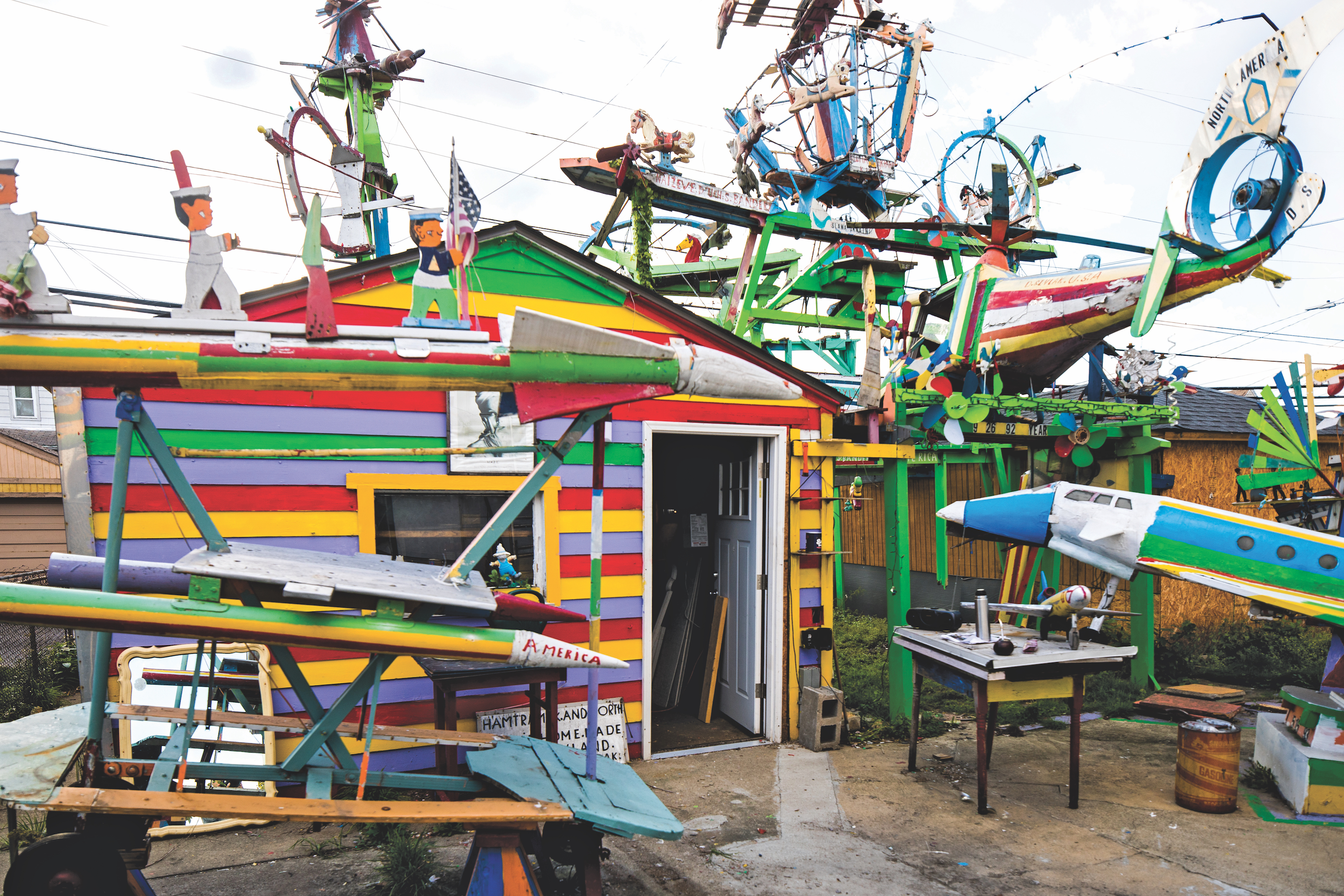
For over 25 years, Hamtramck, a small Michigan city surrounded almost entirely by Detroit, has been home to this unusual folk-art installation. Originally championed by members of Hamtramck’s artist community, it has now welcomed visitors from California, Japan, Germany, Australia, and elsewhere.
The destination has become iconic thanks to the man whose initials, D.S., appear on the tail of the helicopter—Dmytro Szylak, a retired Ukrainian-American auto-plant worker. To keep busy after leaving the working life, Szylak built this curious installation over the roofs of two adjacent houses he owned. Along the way, he became a beloved artist who captured the hope and heartbreak of one small city’s melting-pot culture. Locals named his creation Hamtramck Disneyland, a title he came to embrace.

All year long, the streets of Hamtramck are filled with immigrants from disparate corners of the Earth who are, together, creating a culture that feels unique to this pocket of Michigan. On one day in late March, a young man walking by a towering statue of Pope John Paul II—erected to commemorate the former pontiff’s 1987 visit—stops to make a sign of the cross as the Muslim call to prayer rings out at one of the city’s nearby mosques. At the annual Labor Day festival, women in burqas buy pierogis as their kids ride Ferris wheels. Before Lent, a local donut shop that is run by a Yemeni family makes the Polish pastry known as pączki.
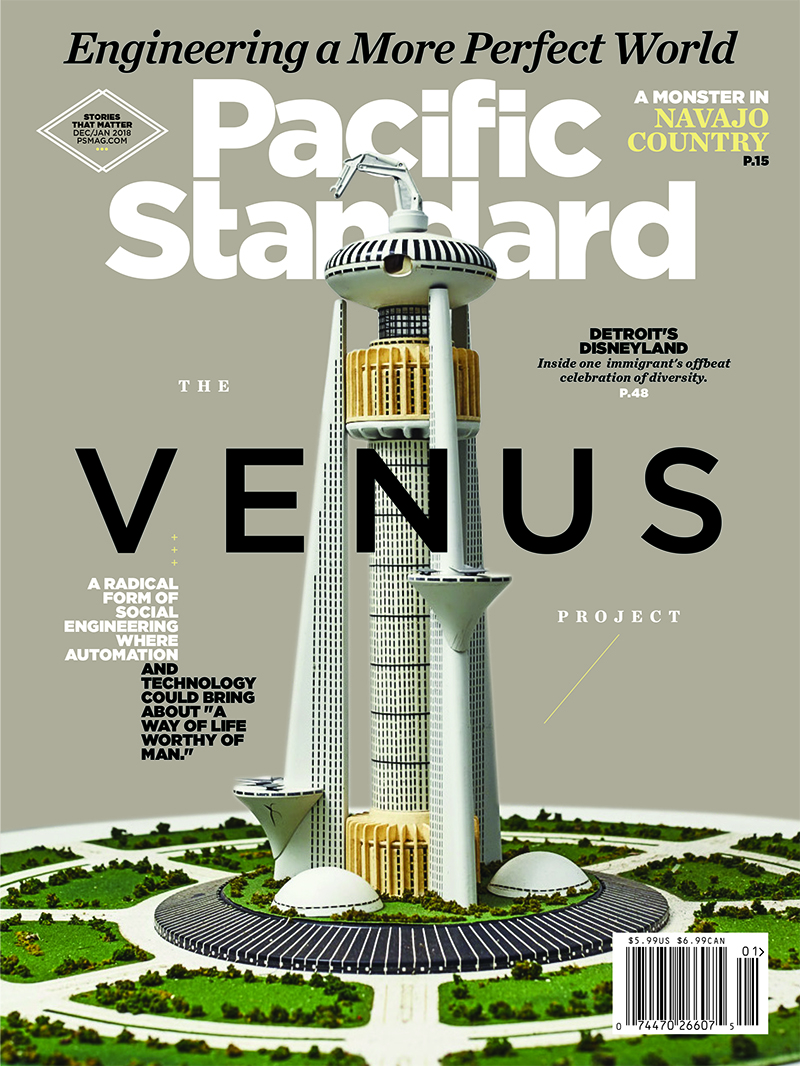
(Photo: Jarren Vink/Pacific Standard)
Scenes like these are a reflection of the fact that Hamtramck’s zip codes—48211 and 48212—are the most diverse in all of Michigan, with about 30 languages spoken on their streets. (Hamtramck now bills itself as “the world in two square miles,” an expression of its concentrated diversity.) The town was settled by German farmers, but when a major wave of Polish migration reached Hamtramck in the mid-1910s, its population swelled from 3,500 to 48,000 in about 10 years. Many migrants sought work in a newly created automotive plant set up by the Dodge brothers, which, as local historian Greg Kowalski writes in his book Hamtramck (Then and Now), came to define Hamtramck, transforming it from a rural community into a rapidly growing city.
Szylak was born in 1922 in the city of Lviv. His arrival in 1949 in America came at the end of a major wave of post-World War II Ukrainian immigration—around 80,000 Ukrainians were resettled in the United States between 1947 and 1951.
Szylak arrived in Hamtramck with his wife, whom he met at a displaced person’s camp, a family lawyer told the Detroit Free Press. He found a well-established Ukrainian community: Thousands of immigrants had settled in the area in the early 20th century, and Ukrainian-owned businesses in Hamtramck included a funeral home and a pharmacy. Szylak became an assembly-line worker at a General Motors factory and started a family. After he retired, he began work on the installation. “I think about what I’ll do, I make a hobby on two garages, on the roof,” he said in an interview with the local paper.
While he was alive, Szylak would light up the installation at night, sometimes scoring the tableau with Ukrainian folk music piped in through speakers. References to his love of both America and Ukraine co-mingle in symbols and snatched words affixed to the work: The installation incorporates American flags and maps, and references to Hamtramck’s mayor, Karen Majewski, a supporter who has called Hamtramck Disneyland “a jewel.” On one wooden board, Szylak wrote “America Big Winner.” On another, the phrase “Ukraine independent from Russia for 23 years” appears, handwritten in yellow paint. Hamtramck Disneyland, over the years, became more than a hobby—it transformed into an artwork telegraphing Szylak’s complex, bifurcated identity.
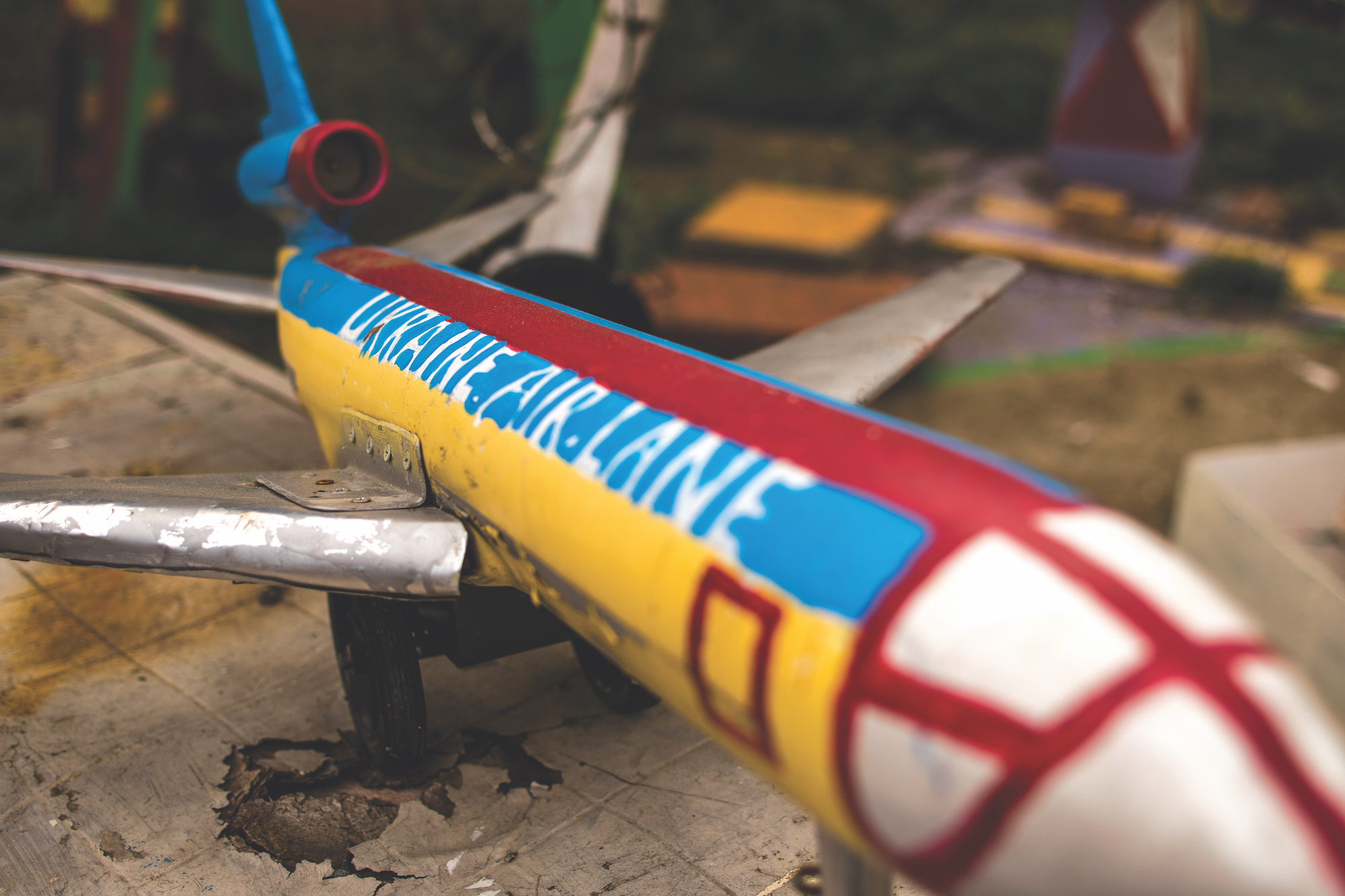
Szylak incorporated references to Ukrainian politics all over the piece, especially to the Ukrainian Insurgent Army, a paramilitary resistance movement that emerged in 1942 with the aim of establishing an independent Ukraine. These Ukrainian and American sentiments suggest the ultimate mark of the immigrant experience: a state in which you exist in two places at once. This often unspoken, tangled duality, a yearning for a home left in the past combined with an appreciation for the one you have, finds expression in the larger structure of Szylak’s work: Tangled symbols, over time, became a bridge, built of reclaimed wood and objects that don’t often find themselves standing side by side.

Hamtramck has long depended on the co-existence of people thrown together from across the globe. This community—many members of which are not Ukrainian—has helped keep Hamtramck Disneyland alive.
The Ukrainian community in Hamtramck, and some neighbors, didn’t initially embrace Szylak’s installation. Pieces of it were included in a Hamtramck art show called Generators and Transmissions in 1999, along with sculptures by celebrated local artist Michael Hall. Szylak’s work began to gain recognition, first from the city’s art community and eventually beyond.
As Szylak continued to add to his installation during his lifetime, the Ukrainian community in his home city began to shrink. Like the Poles and other immigrant groups, many Ukrainians landed in Hamtramck, established their businesses, and left, moving to the suburbs and beyond in search of a lifestyle to reflect their elevated socioeconomic statuses. As upwardly mobile residents left the Detroit area in larger numbers from the late ’60s onward, an influx of refugee populations and immigrants from the Balkans, South Asia, and the Middle East kept Hamtramck alive, and quietly affirmed Hamtramck Disneyland’s status as a unique symbol of the city’s pluralist culture.
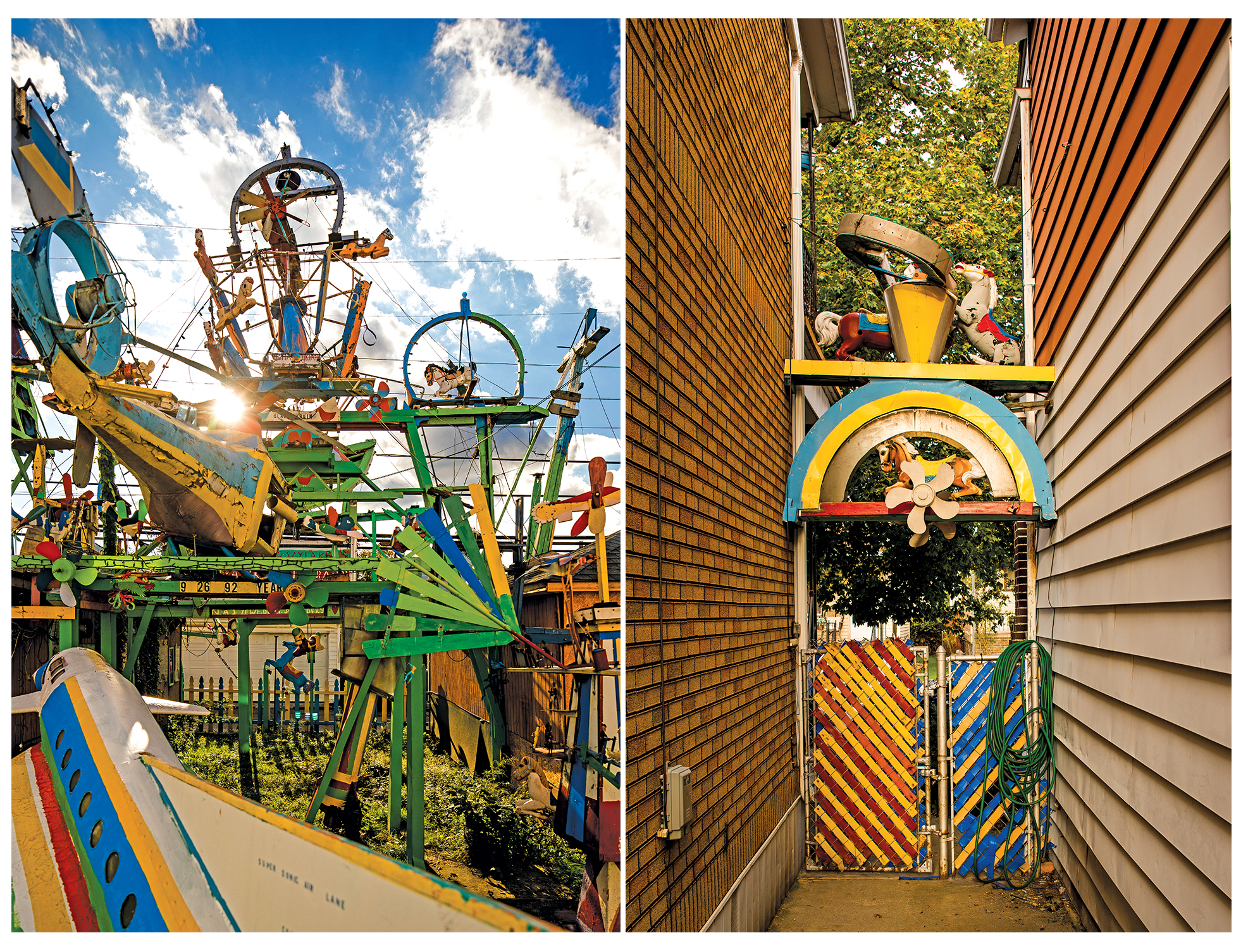
Since Szylak’s death in 2015, and a spat over who owned his homes, community efforts have begun to repair and restore the installation. Now under the ownership of the Hamtramck-based non-profit art collective Hatch Art, Hamtramck Disneyland is home to four artist residencies—one of them international—and has a gallery. Hatch Art has already crowdfunded repair money; locals, including Bengali and Yemeni Americans, have helped with fundraising.
Some of these local donors have only ever seen Hamtramck Disneyland in pictures, or heard about it, fundraisers say. “They were like, ‘It’s bringing people to Hamtramck, so it’s good for our community,'” says Scott Collins, president of Hatch Art’s board of directors. “They were donating unseen and coming to learn about it later.”
Salah Hadwan, a 27-year-old Yemeni American who grew up in Hamtramck and is now a member of the Hamtramck Board of Education, was one of these local supporters. When he found out that the installation might be destroyed, he rallied a popular local restaurant, Royal Kabob, to donate 10 percent of its sales for one day to Hatch Art. Hamtramck Disneyland “shows that, regardless of what’s going on in the U.S., there’s always that hope that you can come to the U.S., come to a city like Hamtramck, and freely express yourself in whatever way you think is unique to you,” he says. “It’s symbolic of immigrants.”
This message resonates in the Detroit area, where outsiders like Szylak have played a fundamental role in building the city through several waves of immigration, from the Great Migration from the Deep South to refugees and immigrants from the Middle East and Europe. These migrants’ combined contributions to the area’s history and economy once helped it become one of the most prosperous cities in America. They are again playing a role in its economic revival: A 2016 report by the state of Michigan found that businesses owned by at least one immigrant in the state generated over $600 million in income in 2014 and employed 152,780 people as of 2007.
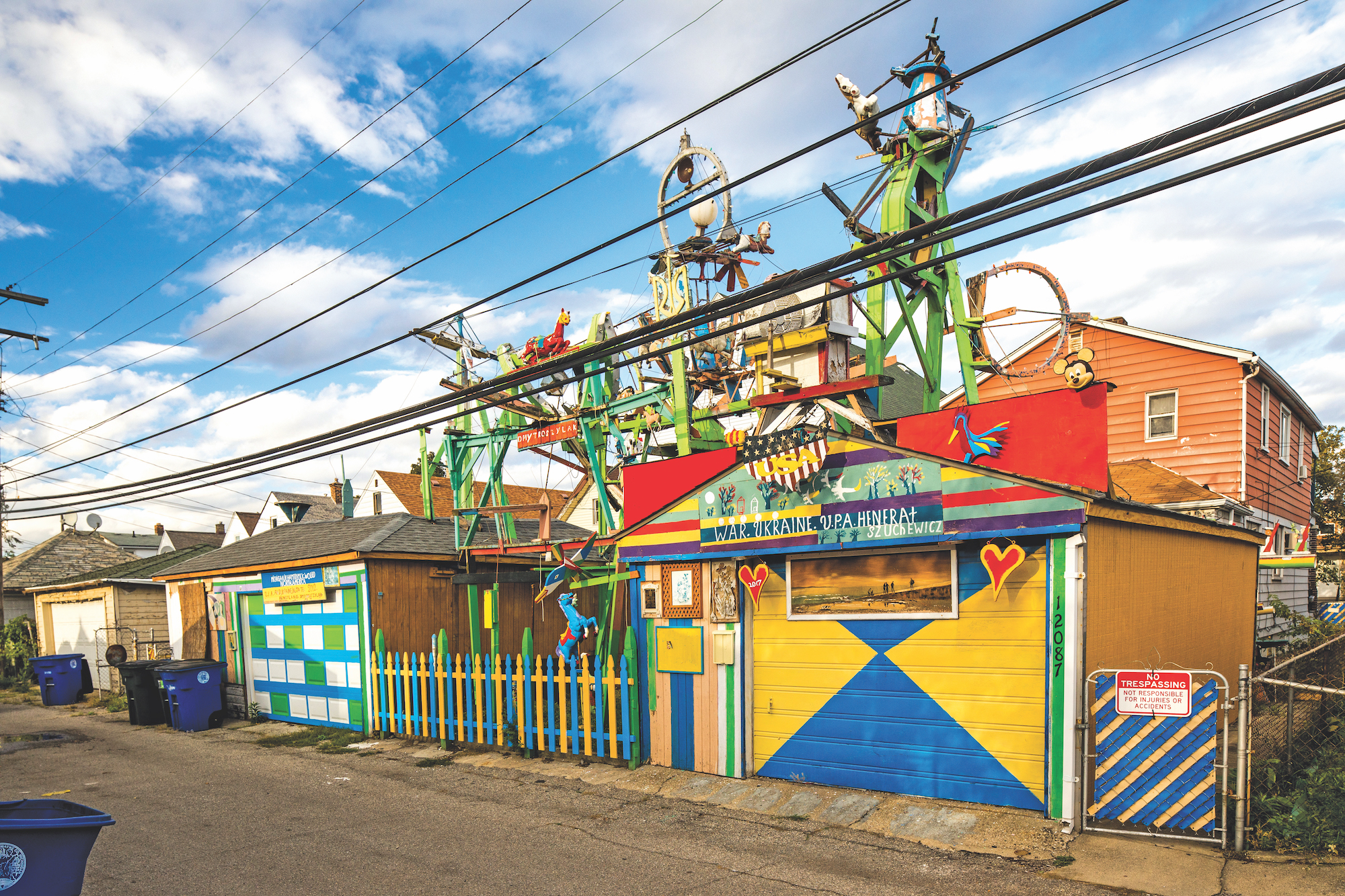
Today, Hamtramck’s politicians are advocating for immigration’s role in sustaining American culture and infrastructure. Earlier this year, around 800 people protested President Donald Trump’s executive order on immigration, signed in January, outside Hamtramck’s city hall. Many were concerned about the effect it could have on the city: If the flow of immigration were to be cut off, Hamtramck might experience devastating social and economic side effects. The next day Hamtramck’s city council passed a resolution rejecting the executive order.
Hamtramck Disneyland’s renaissance in this political climate doesn’t just stand as a testament to the city’s support for its existing immigrant population; it also expresses how the city is constantly reinventing itself to accommodate new residents. All four of Hamtramck Disneyland’s artist residencies have now begun; Renee Willoughby was the first to move in. A multimedia performance artist, Willoughby’s work often focuses on the complex relationships humans have with each other and the places around them.
Willoughby says she’s already found that Szylak’s work is influencing hers. She’s feeling more open to the idea of experimenting in her work and responding to the incompleteness of Hamtramck Disneyland, a work that was never stagnant while Szylak was alive, but was built upon for decades. The conglomeration of wood, whirligigs, and paint over decades mimics the complexity of the immigrant experience—existing in several places at once, places that stretch thousands of miles, the ones we can’t ever go back to again and the ones that gave us the refuge we needed to start all over again.
“I’m really drawn to this,” she says while drinking coffee in her new backyard, where Szylak once greeted his visitors. “I have an affinity for outsider artists because I feel like I never really fit in well into any specific category, so [in Szylak] I kind of found a kindred spirit.”
A version of this story originally appeared in the December/January 2018 issue of Pacific Standard.





